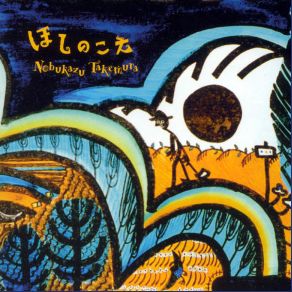Hoshi No Koe
Download links and information about Hoshi No Koe by Nobukazu Takemura. This album was released in 2001 and it belongs to Electronica, Industrial, Rock, J-Pop genres. It contains 11 tracks with total duration of 01:17:51 minutes.

|
|
|---|---|
| Artist: | Nobukazu Takemura |
| Release date: | 2001 |
| Genre: | Electronica, Industrial, Rock, J-Pop |
| Tracks: | 11 |
| Duration: | 01:17:51 |
| Buy it NOW at: | |
| Buy on iTunes $9.99 | |
Tracks
[Edit]| No. | Title | Length |
|---|---|---|
| 1. | One Day | 1:43 |
| 2. | Anemometer | 12:44 |
| 3. | Honey Comb | 3:58 |
| 4. | White Sheep and Small Light | 2:05 |
| 5. | Sign | 7:54 |
| 6. | A Chrysalis | 17:05 |
| 7. | A Theme for Little Animals | 3:11 |
| 8. | Trampoline | 9:24 |
| 9. | Stairs in Stars | 4:16 |
| 10. | In the Room-Roof-Wood | 9:17 |
| 11. | The Voice of a Fish | 6:14 |
Details
[Edit]The two previous full-length albums by Nobukazu Takemura available in the United States were his playful Child's View album Funfair and the much more abstract Scope, released under his own name. In many ways, Hoshi No Koe splits the difference between those two records. That this album can contain the full range of Takemura's musical vision is partly a testament to its extreme length. At nearly 78 minutes, Hoshi No Koe has room for both the extended experiments in microscopic sound manipulation of "Trampoline," which echoes the density of Scope's "Taw," and the gleeful, vocodered pop of "Sign," easily the most traditional song Takemura has done yet. Fortunately, through smart pacing, Takemura managed to create a work that feels something like a coherent album. Of some help are the delicate and melodious music-box style organ pieces that lend thematic unity. The album opens with the gentle "One Day," which is very reminiscent of the meditative work of sometime collaborator Aki Tsuyuko. "Stairs in Stars" is as lovely on the surface as a classic carousel song, and is creepy and dark a layer beneath. The 12-minute "Anemometer" is a fascinating track that explores minimalist ideas of repetition using keyboard patterns, a clarinet, and erratic electronic percussion. "A Chrysalis" evolves over its 16-minute length from seemingly random bells and whines into a dense and lovely drone, and is perhaps the most successful of Takemura's sound experiments. Hoshi No Koe is certainly erratic and unwieldy, but it's packed with breathtaking moments that reward careful listening.